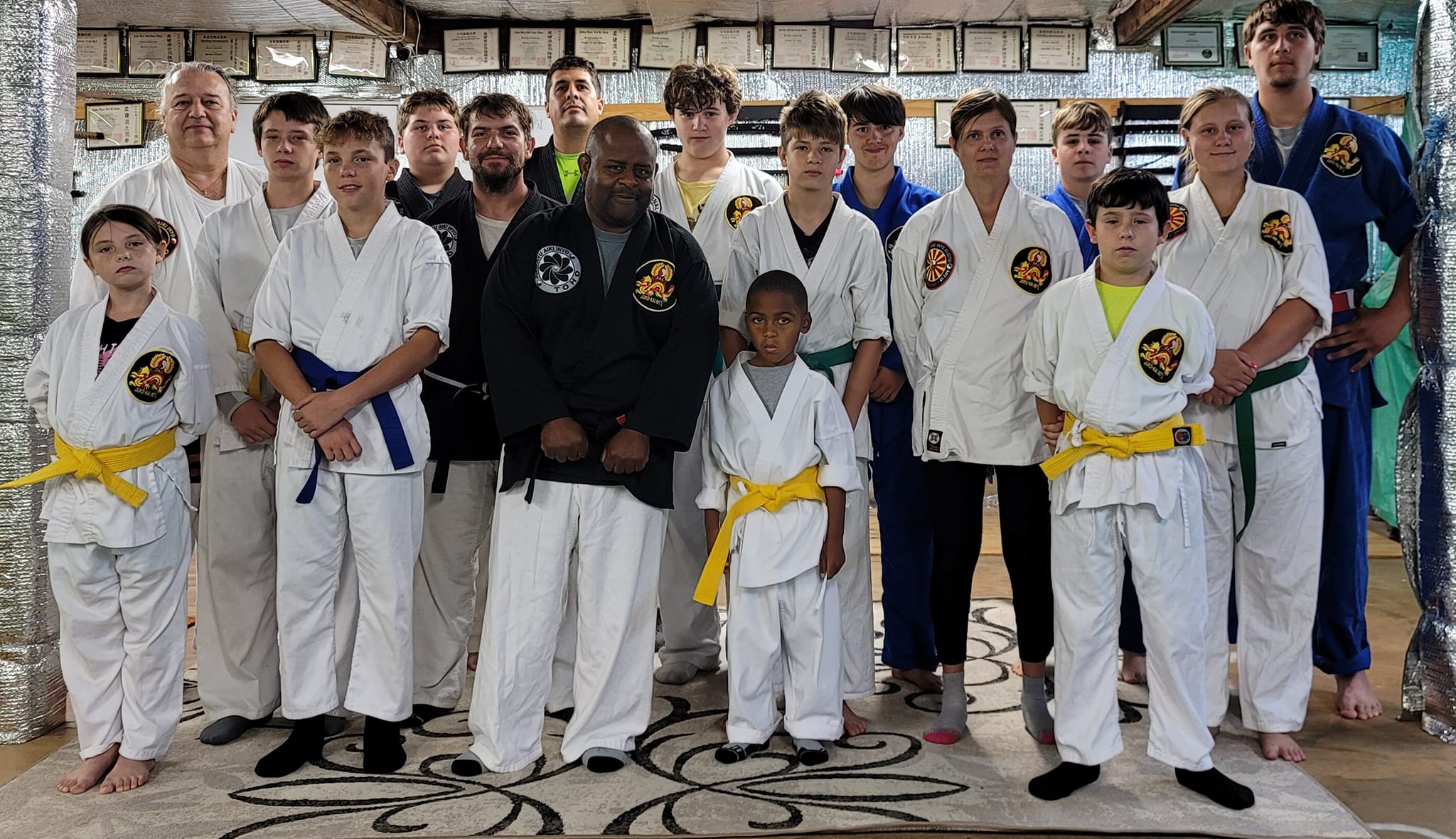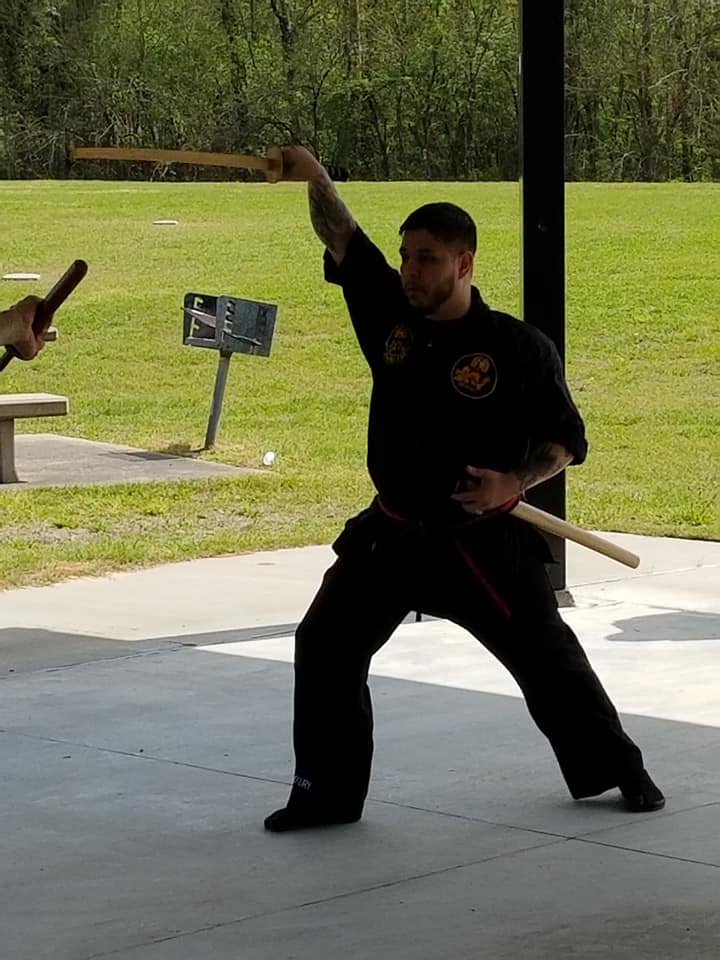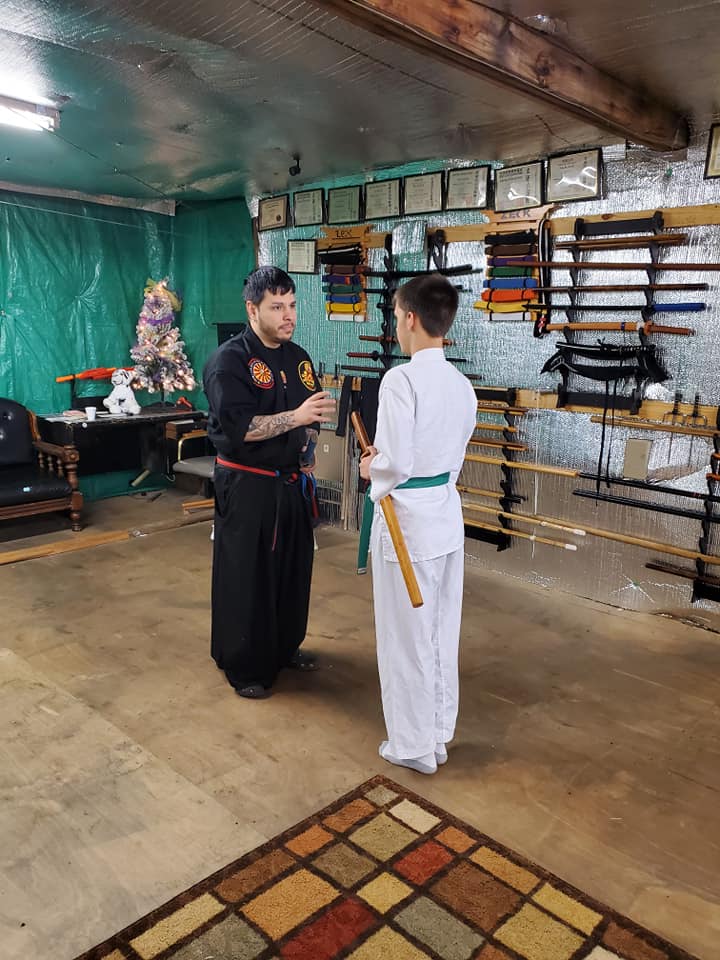Breathing Lessons
Fill Out an Application Now
Article on Health Benefits of Ki-Benefits
This is an excellent article on Juko-ryu Ki-Breathe and its measurable health benefits.
Kung Fu Magazine
February / March 1998
BREATHING LESSONS
Qigong, Lung Capacity and Cardiovascular Risk
by Dr. Lindsay Anglen
Qigong
Qigong is related to acupuncture, and, much like acupuncture, it is thought to control subtle energy and affect health. The Chinese word qigong is roughly translated as “energy work”. Qi refers to a subtle energy. Gong refers to work or study. Most qigong involves controlled breathing, mental concentration and body posturing. It has received attention lately for claims of health benefits in regards to ulcers, blood pressure, cancer, and other illnesses; traditional gigong is believed to improve the ability of the individual to breathe or take in air.
I have learned breath / energy exercises from several sources ranging from China to Tibet, India and Japan. All feature lower abdomen breathing keeping the chest sunken. This is sometimes called diaphragmatic breathing. The Chinese call the lower abdomen the dantien. The Japanese call it the hara.
Qi practitioners state that when doing qigong the chest sinks, while the lower abdomen inflates and deflates like a beach ball, and that this more effectively inflates the lungs as compared to upper chest breathing. A good book on Tai Chi Chuan translates a Chinese text, advising none to “hold the chest in” which is then interpreted as “whenever you inhale, pull your chest in.” (Advanced Yang Style Tai Chi Chuan, Yang Jwing Ming, YMAA, 1989). A similar book on Hsing Yi Chuan reads, “The chest must be round… The chest is relaxed and rounded inward… abdominal breathing can make the muscles which control the expanding and contracting of the lungs more relaxed. This allows the lungs to … take in more oxygen.” (Hsing Yi Chuan, Master Liang Shou-Yu and Dr. Yang Jwing Ming, YMAA, 1990, pp.55 & 70)
Forced Vital Capacity
Does qigong increased forced vital capacity (FVS)? FVC is defined as the maximal volume of gas that can be exhaled from the lungs by forceful effort after a maximum inhale. Dr. Paul Hughes draws on research from Boston Medical School and The American Heart Association. He writes, “Testing lung capacity is the single best indicator of general health status and risk of developing heart disease… the test is better at predicting overall mortality risk and chances of death than measurements such as blood pressure, blood cholesterol, glucose tolerance and even age itself. Studies show that men with the lowest cores had four times the risk of developing heart failure in one year than those with the highest FVC scores. Among women, the highest risk group was almost 20 times more likely to develop heart failure than the lowest risk group. Furthermore, the importance of FVC scores as predictors does not decline with age, as a number of other heart disease factors do.”
The well-known Framingham study followed 5209 men and women. One article reports, ” FVC ranked high as a predictor among the cardiovascular risk factors in men, and second to none (including age) in women. Cardiovascular morbidity, including coronary heart disease, occlusive peripheral artery disease, stroke and cardiac failure, was also strongly related to vital capacity. For cardiovascular morbidity in general, vital capacity was a good predictor in both sexes with a continuing significant association in advanced age. The association persisted even after adjustments for age, cigarette smoking, and hypertension, as well as for other cardiovascular risk factors (glucose tolerance, cholesterol, relative weight)… the strongest correlation observed for FVC is with handgrip strength. This suggests that the FVC may well be a measure of overall vigor and general health. However, there is little evidence to suggest it is a modifiable factor.” (Kannel, W.B., Huber II and Lew E.A., “Vital Capacity as a predictor of Cardiovascular Disease: The Framingham Study,” American Heart Journal, 105:311-315, 1983.) I will show why I do not agree with the last sentence.

Lower Cardiovascular Risk
If a higher FVC is associated with lower cardiovascular risk , then it would seem we should want the highest FVC possible. If qigong could increase FVC, then qigong could reduce the risk of the #1 killer in the USA. I compared the results of regular deep upper chest breathing with dantien (qigong) breathing. I used a calibrated computerized spirometer. Following the methodology of the Framingham study, the best of three efforts was taken as the true vital capacity. I have done research on qigong over the years out of my own personal interest, and in the past whenever I have discovered positive health benefits from qigong I have felt excited as though I unearthed some great archeological find.

Test Results
In our first study we see results of testing on test subject #3 (a 35-year-old male non-smoker.) I will spare you depiction of the graphs and calculations. The bottom line is, the results of deep chest breathing far exceeded those of dantien breathing. Testing was done 10 times on different individuals including smokers and non-smokers. Subject #3 was indicative of the average results. We are looking at FVC, not other factors as FEV I.
These are the following results on subject #3
Trial test A. Deep upper chest breathing
9/26/96 7:30AM
The estimated value was 5.56 liters. The actual value of the subject was 4.6 liters. This was 82% of the estimated value. The computerized interpretation was that of a normal spirometry. The estimated biological lung age was 34.1 years.
Trial test B. Dantien Breathing.
9/26/96 7:35 AM
The predicted value was of course the same. The actual tested value of the subject was 4.13 liters of lung gas when using dantien breathing. This was 74% of the predicted value. The computerized interpretation was that of mild restriction. The computerized estimated biological lung age was 44.7 years. Dantien breathing was definitely was LESS effective than regular deep breathing.
I have long been a fan of qi-related phenomenon. However, being a fan does not preclude me from trying to think openly or rationally. When I first performed the test it was a real disappointment. I have practiced qi exercise for years and taught the same to my students. This reminded me of a Christmas about 30 years ago. I was about the age of 5 and I had just told my younger cousin that there was no Santa, thinking that I had done her a favor. She ran off crying and I was soon confronted by my angry aunt. The truth sometimes hurts. However, I have to report what I find to be true, even if not what I expected. Science should be the observation of truth, not an effort to prove what one wants to be true.

Kijutsu Energy and Rod Sacharnoski
After about 2 months of sulking, I had the opportunity to study a modern method that draws heavily on the Chinese qigong called Juko-ryu Kijutsu. This translates roughly as “the Juko school energy technique.” These tests on #3 actually were done after learning Kijutsu, although original comparisons of Qigong vs. Chest breathing began weeks prior.
Let me digress for a moment. In 1974 my friend saw a Wide World of Sports demo where Rod Sacharnoski and his team gave a Combat-Ki demonstration in which Joe Hess -the then Full Contact Heavyweight Karate champion- struck and kicked them in the vital areas of the human body…including a full power testicle kick. There was no pain or injury. My friend knew I studied martial arts and asked how that could be done, I said, “It is impossible.” However, his persistence on what he saw stuck in my mind.
Years later I found out that this feat was quite real. The practitioner was none other than Dr. Rod Sacharnoski. I also learned of other feats performed by him and his students. His “Combat Ki” (what he terms his system of Kijutsu relating to the acceptance of full power strikes to the vital areas) were legendary. His demonstrations were featured in many magazines. His 1974 exhibition at Madison Square Garden brought instant fame, as did his highly renown demonstration at Ed Parker’s 1975 Long Beach Internationals. Ed Parker and Dr. Sacharnoski were close friends for years. One famous clinic took place in 1988 for the Dallas Cowboys football team. Such greats as Herschel Walker, Randy White, Ed “Too Tall” Jones (former heavy weight boxer), and many others tried to knock Dr Sacharnoski and his students down by kicking them full focus in the testicles, and punching them full force in the Adam’s apple, jugular veins (side of neck), solar plexus, etc. This amazing event was featured in the Dallas and Ft. Worth newspapers and on television’s many national talk shows. Up to four football players at one time did the actual striking. Such exhibitions were “old time” stuff to Dr. Sacharnoski and his specially trained crew, who traveled the world performing such feats. Dr. Sacharnoski has carried a $100 bill for 36 years which he would give to the person who could knock his men down to their knees. Professional boxers, top martial artists, strongmen and thousands of others have tried, and so far no one has claimed the money.

Ki – Soft and Hard
When I learned Kijutsu, Dr. Sacharnoski spent considerable time training everyone in the soft aspect of Ki. Later, those who wanted to practice the hard aspects were able to do so. This involved taking blows to all parts of the body. Both sexes and people of all ages participated. I saw blindfolded people, standing relaxed, receiving strikes so hard from several people at once that they literally flew several feet through the air land on their (this portion occluded on my copy… sorry)…. your feet to pass the test.” There are 6 levels, each called a Menkyo: Menkyo Chuden, Menkyo Joden, Menkyo Okuden, Menkyo Kyoshi, Menkyo Shihan-dai, Menkyo Shihan. I passed the Menkyo Okuden level (literally -entrance to secrets). We were not being encouraged to be “tough” and swallow pain. If Ki was present, no pain or injury occurred. The training seems to be like in anything else, like weightlifting or swimming, that the more deeply you practice the better you can be. I am so-so.
Testing with Kijutsu
I decided to make another test, this time using Kijutsu breathing.
Here are the results of Forced Vital Capacity test on Subject #3. Trial test C. Juko-ryu-proper Kijutsu breath.
9/26/96 7:45 AM The actual value measured was 5.62 liters. This was interpreted as a normal spirometry. The estimated lung age was 25.3 years. The Kijutsu breath produced the greatest results so far.
I wondered if continued practice would result in further improvement. So daily practice was instituted, in moderation. I did not want to make it as ridiculous as experiments on diet where a rat must 10,000 times its weight in dryer lint to prove it is dangerous. Each participant practiced 5 Ki breaths daily – that’s all. Results on subject #3 are in illustration #4.
These are the next results: Trial D. Juko-ryu Ki-Breath 10/6/96 7:12 PM Briefly, this showed a normal spirometry with an estimated lung age of 19.7 years.Roughly two weeks of light practice appeared to improve FVC even further. This would suggest that it “de-aged” the lungs biologically.
The Proper Juko Ryu Ki Breath
Lets look at how the “Proper Juko ryu Ki breath” is performed (photo series 1-4). First, begin in a neutral position (photo 1). Then, continue as though doing traditional dantien breathing (photo 2). By this, I mean that the lower abdomen inflates as one draws in air. Next, the middle abdomen / lower chest expands followed by the upper chest (photo 3). As the upper chest (middle dantien) starts to expand the shoulders to to draw back slightly (photo4) to expand the chest. If the ribs do not move, the lungs are not inflating fully. Keeping the chest sunken while breathing is directly opposed to getting as much air as possible.
The proper Ki-breath combines dantien breathing and upper chest breathing. It is my observation that neither dantien nor chest breathing alone is sufficient to fully utilize the lungs. This seems a very simple assumption; however, having studied other system over the last 20 years I find it is the dantien type of breathing that is emphasized. I have trained deeply in several systems. I have seen an exercise practiced by one Bagua system that uses upper chest breathing, which seems to be a preparatory exercise, though I have not studied this one particular system of Bagua deeply. I am not saying there is no benefit to dantien breathing, but – it isn’t the best way of getting maximum air.
Sacharnoski and Combat Ki
Let’s look at Dr. Sacharnoski, whose Ph.D. is in law enforcement, a veteran with more than 25 years in the police fields. He served in Federal, County and Municipal law enforcements. He has honorable discharges from the U.S. Marines and U.S. Army. Needless to say, his life has been in danger many times. His Ki feats are highly dangerous themselves, and can result in severe injury and/or death.
His training began in 1954 in Dai Yoshin-ryu Bujutsu. In the U.S. Marines, at the age of 19, he was stationed on Okinawa, and began his traditional Karate, Kobudo, and Toide studies in earnest. he was a renowned Judo practitioner and served as Chief Instructor of the 3rd Marine Division Judo Club (1960-1961). He studied the Chinese arts of Chang Ch’uan, Pai Hao Ch’uan, and Tai Chi. His martial arts achievements are too numerous to list since he has more than 40 years of training in the martial arts of Okinawa, Japan, and China.
Dr. Sacharnoski is the only known non-Asian to achieve the 10th Dan Soke (Founder) recognition in both Okinawa and Japan. In 1961 he was recognized as the Soke of a system known as Juko-ryu. In 1973, he founded the first Soke Society in the Western world. Because of him, the formal Asian process of earning a traditional foundership became known.
I have heard well-known martial art / qigong master question the reality of Combat Ki. One book states. “The reason for names (iron shirt or Golden Bell cover) is that the training will enable a person to resist a blow or punch without injury or pain… There are two vital places, the eyes and the groin, where Chi cannot be directed… there are some practitioners who are able to pull there testicles up into the abdomen…”(Chi Kung – Health and the Marital Arts, pp.113-114. YMAA 1990. Dr Yang Jwing Min). I can say authoritatively and factually that this is not true and that no Combat Ki person pulls their testicles up into their body.
It was said years ago by other experts that Dr. Sacharnoski would not live to the age of 40 because of his demonstrations. On the contrary, his Kijutsu may be part of the reason that in his fifties he still tours the USA giving seminars almost on a weekly basis year round, to classes of hundreds of students from all over the world.
Model A, Ford or Lexus?
Jane Heimlich (“What the Doctor Won’t Tell You.” Health and Healing, Aug. 1993 Vol.3 No.8) quotes Dr. John Clarke who worked as a hospital cardiologist. He reports that “breathing properly might even help prevent a heart attack,” and teaches all his patients how to breathe properly. When concentration and faith are added, as in qigong, dramatic things can happen. Such methods have been around for thousands of years. I have found these ancient methods beneficial. However, we may be able to make even more progress. many admire the Model A Ford automobile, but few would hesitate to notice the improvements in a 1996 Lexus.
Much of Chinese philosophy is based on concepts of yin/yang, the five elements, and Bagua. Bagua is the concept of change. For there to be life, change is necessary. To maintain a constant body temperature we much change things like our clothes, and our thermostats, with the seasons. Instructors in the USA seem to fear Dr. Sacharnoski’s teaching because in some ways it is a change from their teachings. Like Copernicus of old, called before the Roman inquisition as a heretic for his new scientific views of the earth revolving around the sun (contradicting the church’s view that the earth was the center of the universe), Dr. Sacharnoski’s instruction in breath method and absorbing blows has at times contradicted the teaching of many other authorities in the USA. But is hard to argue with results.


